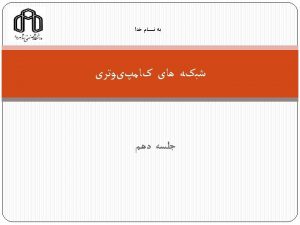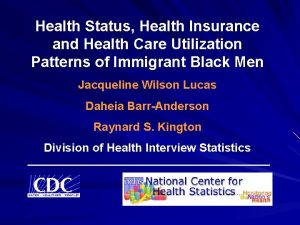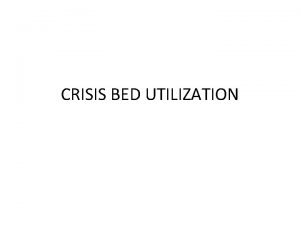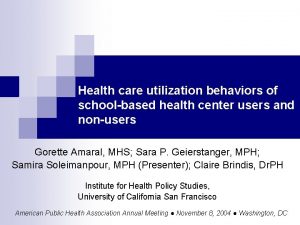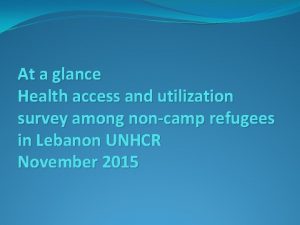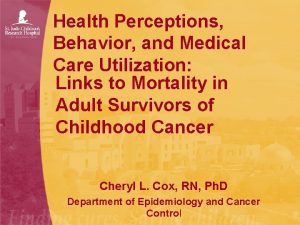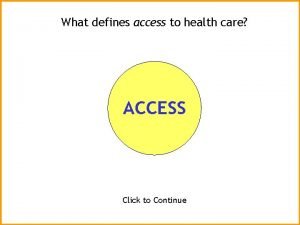Access to health care and health care utilization






















- Slides: 22

Access to health care and health care utilization among Hispanic/Latino women in the United States, 2000 -2002 Gulnur Scott, M. P. A. Margaret Lethbridge-Çejku, Ph. D Division of Health Interview Statistics U. S. DEPARTMENT OF HEALTH AND HUMAN SERVICES Centers for Disease Control and Prevention National Center for Health Statistics

Background Ø Access to health care is an important determinant of the quality of health care, the quality and years of healthy life and the presence or absence of health disparities Ø Race/ethnicity is one of the key factors that contributes to disparities in health and health care utilization Ø Hispanic/Latinos are more likely to lack access to health care than persons of other racial and ethnic groups Ø The Hispanic/Latino population in the US is very diverse Ø Understanding differences among Hispanic/Latino subpopulations will help inform health policies and programs

Objectives To assess subgroup differences in access to care and health care utilization among Hispanic/Latino women by examining: Ø Health insurance coverage Ø Having a usual place of health care Ø Experiencing unmet medical need due to cost

Access to health care Health Insurance: Ø Insured: Covered by private or public (Medicaid, Medicare, or other public) health insurance Ø Uninsured: Not covered by any kind of comprehensive health insurance or health care plan – includes women with only IHS Usual source of care: Ø One or more places to go, other than hospital emergency room, when sick or in need of health advice Unmet medical needs: Ø Could not afford medical care, prescription medication, eye glasses, dental care, mental health care or counseling Ø Delayed care because of cost

Hispanic/Latino women in the National Health Interview Survey Ø Ø Black and Hispanic/Latino populations oversampled Three data years combined to provide estimates for Hispanic/Latino subpopulations Hispanic/Latino women in the US, ages 18 + Hispanic/Latino subpopulations: Ø Ø Ø Mexican or Mexican-American Puerto Rican Cuban or Cuban American Central or South American Other Hispanic (Dominican Republic, Other Latin American, Other Hispanic/Latino)

Data analysis Ø SUDAAN software Ø Estimates weighted to reflect national estimates Ø Annualized sample size=3027 Hispanic/Latino women per year Ø Annualized weighted estimate =11, 159, 088 (~11% of women in US population) Ø Non-Hispanic black women and non-Hispanic white women used as reference populations Ø Three risk factors for lack of access to care investigated: poverty (as defined by US Census), lack of high school education, and family size of 6 or more members

Hispanic/Latino women in the U. S. Puerto Rican Mexican Cuban Central or South American Other Hispanic Data Source: National Health Interview Survey 2000 -2002 Preliminary Data

ACCESS TO CARE AMONG US HISPANIC/LATINO WOMEN No health insurance coverage % Data Source: National Health Interview Survey 2000 -2002 Preliminary Data

ACCESS TO CARE AMONG US HISPANIC/LATINO WOMEN No usual place of care % Data Source: National Health Interview Survey 2000 -2002 Preliminary Data

ACCESS TO CARE AMONG US HISPANIC/LATINO WOMEN Unmet medical needs % Data Source: National Health Interview Survey 2000 -2002 Preliminary Data

ACCESS TO CARE AMONG US HISPANIC/LATINO WOMEN Poor women without health insurance % Data Source: National Health Interview Survey 2000 -2002 Preliminary Data

ACCESS TO CARE AMONG US HISPANIC/LATINO WOMEN Poor women with no usual place of care % Data Source: National Health Interview Survey 2000 -2002 Preliminary Data

ACCESS TO CARE AMONG US HISPANIC/LATINO WOMEN Poor women with unmet medical needs % Data Source: National Health Interview Survey 2000 -2002 Preliminary Data

ACCESS TO CARE AMONG US HISPANIC/LATINO WOMEN Less than HS education without health insurance % Data Source: National Health Interview Survey 2000 -2002 Preliminary Data

ACCESS TO CARE AMONG US HISPANIC/LATINO WOMEN Less than HS education with no usual place of care % Data Source: National Health Interview Survey 2000 -2002 Preliminary Data

ACCESS TO CARE AMONG US HISPANIC/LATINO WOMEN Less than HS education with unmet medical needs % Data Source: National Health Interview Survey 2000 -2002 Preliminary Data

ACCESS TO CARE AMONG US HISPANIC/LATINO WOMEN 6+ family members without health insurance % Data Source: National Health Interview Survey 2000 -2002 Preliminary Data

ACCESS TO CARE AMONG US HISPANIC/LATINO WOMEN 6+ family members with no usual place of care % Data Source: National Health Interview Survey 2000 -2002 Preliminary Data

ACCESS TO CARE AMONG US HISPANIC/LATINO WOMEN 6+ family members with unmet medical needs % Data Source: National Health Interview Survey 2000 -2002 Preliminary Data

Summary Ø Ø Ø 34% of Hispanic/Latino women were uninsured, 22% had no usual place of care, and 22% had unmet medical needs Poverty, having less than a HS education, and large family size were associated with lack of health insurance and lacking a usual place of care in all women, but appear to have a greater impact on Hispanic/Latino women Mexican and Central / South American women were disproportionately represented among Hispanic/Latino women who lacked insurance, a usual place of care, and who had unmet medical needs 75% of Hispanic/Latino women in the US are Mexican or Central/South American; 58% are Mexican 41% of Mexican women were poor, 50% had less than a HS education, and 19% had large families of 6 or more

Conclusions Ø Ø Ø Disparities in access to care and health care utilization were found among subgroups of Hispanic/Latino women in the US Much of the disparity in access to care between Hispanic women and non-Hispanic white and black women is driven by lack of access to care among Mexican and Central and South American women in the US Even among women who shared characteristics shown to be associated with a lack of health care access poverty, lack of education, and large family size – a greater proportion of Mexican and Central/South American women were adversely impacted compared with other Hispanic/Latino women, and compared with non-Hispanic black and white women

Percentage of Hispanic/Latino and non -Hispanic women in the U. S. 2000 % Hispanic/Latino 10. 7 11. 0 Non-Hispanic white 76. 9 Non-Hispanic black 12. 4 Data Source: National Health Interview Survey 2000 -2002 2001 % 76. 5 12. 5 11. 3 Preliminary Data 2002 % 76. 2 12. 5
 Health and social care component 3 health and wellbeing
Health and social care component 3 health and wellbeing Warehouse objectives and goals
Warehouse objectives and goals Bandwidth utilization multiplexing and spreading
Bandwidth utilization multiplexing and spreading Bandwidth utilization multiplexing and spreading
Bandwidth utilization multiplexing and spreading Va office of small and disadvantaged business utilization
Va office of small and disadvantaged business utilization Link utilization
Link utilization Bandwidth utilization multiplexing and spreading
Bandwidth utilization multiplexing and spreading Unit 2 equality diversity and rights
Unit 2 equality diversity and rights Terminal access controller access-control system
Terminal access controller access-control system Terminal access controller access-control system
Terminal access controller access-control system Primary secondary tertiary care nursing
Primary secondary tertiary care nursing Utilization law
Utilization law Performance parameters of half wave rectifier
Performance parameters of half wave rectifier Esa pus
Esa pus Cube utilization formula
Cube utilization formula Citrate utilization test
Citrate utilization test Citrate results
Citrate results Tsi test: principle
Tsi test: principle Energy definition
Energy definition Drug utilization review template
Drug utilization review template Data utilization strategies
Data utilization strategies Asset utilization formula
Asset utilization formula Load distance model
Load distance model





